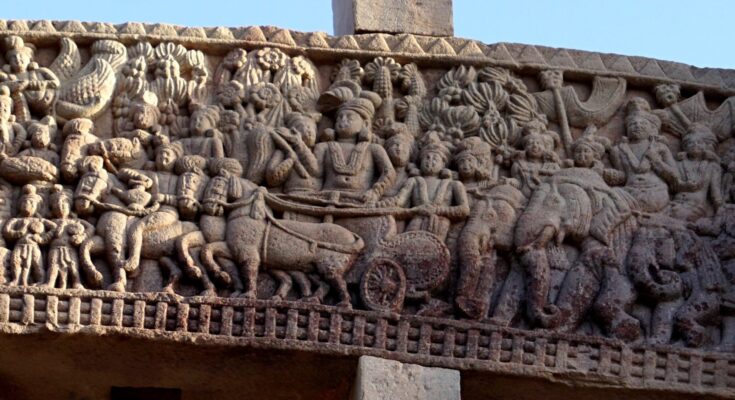Considered the Constantine of the Buddhist world, Ashoka the Great is renowned for his pivotal role in spreading Buddhism across Asia. His reign highlights significant cultural and historical connections between ancient India and Greece. This article explores how Ashoka’s policies and Greek inscriptions reflect the deep interconnection between these two ancient civilizations.
Ashoka the Great

Although Indian texts say little about Ashoka due to his Buddhist beliefs, Pāli, Chinese, Sanskrit, and Tibetan sources describe him as India’s most significant Buddhist king. Ashoka the Great ruled the Mauryan Empire from 268 to 233 BC. Known for his conversion to Buddhism after the bloody Kalinga War, Ashoka dedicated his life to spreading Buddhist teachings and values throughout his vast empire. His reign is characterized by his promotion of non-violence, religious tolerance, and welfare for his subjects. However, his reign is also notable for the significant Greek influence that permeated his court and policies, a testament to the rich cultural exchange between India and Greece during his time.
Greek influence in the Maurya Empire

Chandragupta Maurya, Ashoka’s grandfather, founded the Mauryan Empire and significantly expanded its territory through both military conquests and strategic alliances. One of the most strategic alliances formed during this expansion was with the Seleucid Empire, led by Seleucus I Nicator. This alliance, secured through a treaty, ceded eastern territories of the Seleucid Empire to Chandragupta in exchange for 500 war elephants, a highly valued military asset at the time.
According to Megasthenes, the treaty was also sealed with a marriage alliance, possibly between a Seleucid princess, Helen, and Chandragupta or his son Bindusara, Ashoka’s father. Woodcock, in his 1966, The Greeks in India, theorizes that this marriage alliance would make Ashoka half or a quarter Greek.
Greek ambassadors like Megasthenes and Deimachus were sent to the Mauryan court to facilitate cultural and diplomatic exchanges. Megasthenes, in particular, wrote extensively about India, providing one of the earliest and most comprehensive subcontinent accounts available to the Greek world. These connections laid the groundwork for the Greek influence observed during Ashoka’s reign, fostering an environment of mutual respect and cultural exchange.
Ashoka’s Greek edicts

One of the most compelling pieces of evidence of Greek influence during Ashoka’s reign is his use of Greek in official edicts. These inscriptions were particularly prevalent in Kandahar, Afghanistan, known as Alexandria in Arachosia in Greek sources. Ashoka’s Greek inscriptions included Edicts XII, XIII, and a Minor Edict, which detailed his conversion to Buddhism and the principles he adopted.
Ashoka’s Greek edicts reported on his commitment to Buddhism and his policies promoting nonviolence, vegetarianism, and respect for parents. The edicts were inscribed on polished rock and displayed on public monuments, making his declarations accessible to the diverse populace of his empire. The fluency and sophistication of the Greek used in these inscriptions suggest a well-established Greek-speaking community within the Mauryan Empire, indicating that Greek was not merely a diplomatic language but also a medium for spreading religious and ethical teachings.
Ashoka’s efforts to communicate his Buddhist principles to his Greek subjects indicate a significant cultural and religious exchange between the two civilizations. The presence of Greek Buddhists in the Mauryan Empire is a testament to Ashoka’s successful proselytizing efforts. This blending of Greek and Indian spiritual practices created a unique cultural milieu where Greek philosophy and Buddhist teachings coexisted and influenced each other.
Cultural and religious exchange

Given that the conversion of many Greeks to Buddhism dates back to Ashoka’s reign, these attempts at appealing to Mauryan Greeks seem to have been successful. The fluency of Greek in the edicts suggests that a community of Greek Buddhists must have lived in the Mauryan Empire, with a native level of Greek and familiarity with Buddhist precepts. This indicates not only the acceptance but also the integration of Buddhist values within the Greek community.
Marshall, in his 1960 book The Buddhist Art of Gandhara, hypothesized that Buddhism’s logical and ethical character, as well as its stress on free will and the observance of the golden mean, would have strongly reverberated with Greek followers. More recently, the Indian scholar Thapar, in her 2015 book Asoka and the Decline of the Maurya, argues that the phraseology in Ashoka’s Edicts “echoes Platonic and Pythagorean thought.”
Evidence indeed suggests that ideas like the notion of a Universal Ruler (Cakkavattin), law or justice (dharma), and vegetarianism may have found resonance with the Indo-Greek laity because they were in dialogue with Greek ideas such as the Platonic notion of the Philosopher King, εὐσέβεια/δίκη, and Pythagorean vegetarianism.
Ashoka’s legacy in Greco-Buddhism

The legacy of Ashoka the Great extends beyond his contributions to Buddhism. His reign exemplifies the rich cultural exchanges between ancient Greece and India. The diplomatic and cultural ties established during his reign fostered a period of mutual influence and respect between the two civilizations. These historical connections have had a lasting impact, influencing contemporary understandings of both Greek and Indian cultures.
The interactions between the Greek and Indian worlds during Ashoka’s reign contributed to a greater understanding and appreciation of each other’s philosophies and religions. This blending of cultures can be seen in the syncretic art and architecture of the period, such as the Greco-Buddhist art of Gandhara, which combines Greek artistic techniques with Buddhist themes. Ashoka’s use of Greek in his edicts also set a precedent for future rulers in India to adopt and integrate foreign elements into their governance and cultural practices.
Ashoka the Great: The Greek connection in ancient Indian history
Ashoka the Great’s reign is a remarkable example of cultural and religious integration. His use of Greek in official edicts and the presence of Greek communities within his empire underscore the deep interconnections between ancient Greece and India. By bridging these two great civilizations, Ashoka’s legacy continues to inspire and inform our understanding of historical cultural exchanges.



